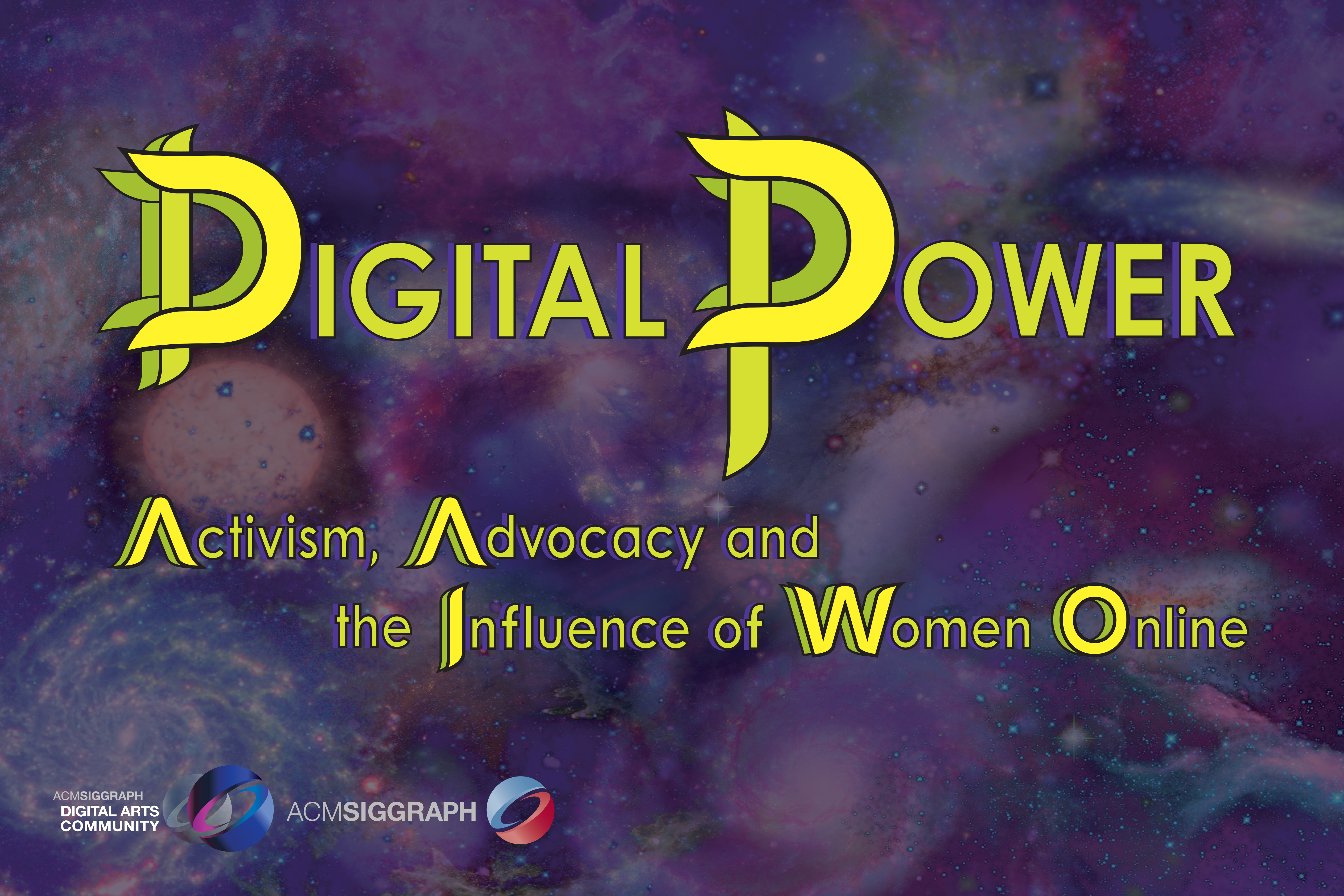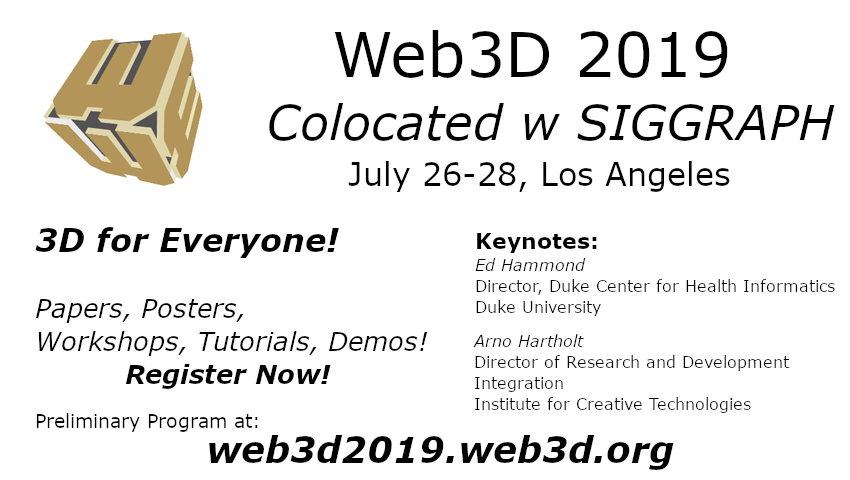Call for Journal Papers
IEEE VR 2020: the 27th IEEE Conference on Virtual Reality and 3D User Interfaces
March 22-26, 2020, Atlanta, USA
Important Dates
Journal Track
- September 3, 2019: Abstracts due (REQUIRED)
- September 10, 2019: Submissions due
- November 9, 2019: Notification of first review cycle results
- January 6, 2020: Revised paper submissions due to second review cycle
- January 22, 2020: Final notifications
- January 31, 2020: Camera-ready material due from authors of accepted papers
Conference Track
- November 16: Conference paper abstracts due (REQUIRED)
- November 23: Conference paper submissions due
- January 26: Conference paper notifications of results returned to authors
- February 9: Camera-ready material due from authors of accepted conference papers
Overview
IEEE VR 2020 seeks original, high-quality papers in all areas related to virtual reality (VR), including augmented reality (AR), mixed reality (MR), and 3D user interfaces (3DUIs).
Inquiries contact: program2020 [at] ieeevr.org
Submission Guidelines
Paper abstracts and complete papers must be submitted electronically through the online submission system: https://new.precisionconference.com/~vr
Each research paper should provide a validated contribution covering one or more of the following categories: methodological, technology, applications, and systems.
- Methodological papers should describe advances in theories and methods of AR/VR/MR and 3DUI, such as ethical issues, theories on presence, or human factors.
- Technology papers should describe advancements in algorithms or devices critical to AR/VR/MR and 3DUI development such as input, display, user interaction, or tracking.
- Application papers provide an important insight to the community by explaining how the authors built upon existing ideas and applied them to solve an interesting problem in a novel way. Each paper should include an evaluation of the success of the use of AR/VR/MR and/or 3DUI in the given application domain.
- System papers should indicate how the developers integrated techniques and technologies to produce an effective system, and convey any lessons learned in the process.
Each paper should include an evaluation of its contributions, such as user studies, benchmarking and/or comparison with existing systems/techniques/methods.
Further Details Regarding Submissions. We welcome paper submissions not exceeding 9 pages, excluding references. References may not exceed two additional pages. Continuing our cooperation with the IEEE Transactions on Visualization and Computer Graphics (TVCG), all accepted paper submissions will automatically be published in a special issue of IEEE TVCG. To meet TVCG standards, papers recommended for inclusion to TVCG will undergo a two-stage review process (see SUBMISSION DEADLINES below). Authors of papers that are determined to be acceptable to the journal subject to minor revisions during the first review cycle will be invited to submit a revised version for a second review cycle. Only papers that are accepted in this second cycle will appear in the journal issue. Papers that fail to pass the second round of reviews may proceed through further revisions to appear in a future regular issue of TVCG.
Ethics and Responsibility. All submissions describing research experiments with human participants should follow the appropriate ethical guidelines and authors are encouraged to secure and report their pre-approval by the relevant ethics commission. An approval by any institutional review board should be indicated via the submission system. While this is not a mandatory requirement at this time, with the broad dissemination of VR, AR, and MR technology, our community should be aware of this responsibility.
Conference Presentation. All accepted papers must be orally presented at the conference. There is also the possibility for authors of relevant previously published TVCG papers (accepted within the last year) to present their work at IEEE VR 2020. Interested authors should contact the program chairs for more details.
Abstract Submission. Note that a paper abstract must be uploaded a week prior to the actual paper submission deadline. This facilitates the process of assigning reviewers, as the review process operates on a very tight schedule.
Topics
IEEE VR 2020 seeks contributions in VR/AR/MR and 3DUI including, but not limited to, the following topics:
- 3D and volumetric display and projection technology
- 3D authoring
- 3D user interaction
- 3DUI metaphors
- Audio interfaces, sound rendering, spatialized audio, auditory perception and psychoacoustics
- Collaborative interactions
- Computer graphics techniques
- Crowd simulation
- Embodied agents, virtual humans and (self-)avatars
- Ethical issues
- Haptic and tactile interfaces, wearable haptics, passive haptics, pseudo haptics, other touch-based UI
- Human factors and ergonomics
- Immersive / 360° video
- Immersive analytics and visualization
- Input devices
- Locomotion and navigation
- Mediated and diminished reality
- Mobile, desktop or hybrid 3DUIs
- Modeling and simulation
- Multi-user and distributed systems
- Multimodal capturing and reconstruction
- Multimodal input and output
- Multimodal/cross-modal Interaction and perception
- Multisensory rendering, registration, and synchronization
- Non-fatiguing 3DUIs
- Non-visual interfaces (such as olfactory)
- Perception and cognition
- Presence, body ownership, and agency
- Scene description and management issues
- Software architectures, toolkits, and engineering
- Storytelling
- Teleoperation and telepresence
- Therapy and rehabilitation
- Touch, tangible and gesture interfaces
- Tracking and sensing
- Usage research, evaluation methods and empirical studies
Additional Submission Guidelines
All paper submissions must be in English.
Paper submissions must not have been previously published. A manuscript is considered to have been previously published if it has appeared in a peer-reviewed journal, magazine, book, or meeting proceedings that is reliably and permanently available afterward in print or electronic form to non-attendees, regardless of the language of that publication. A paper identical or substantially similar in content (in its entirety or in part) to one submitted to VR should not be simultaneously under consideration for another conference or journal during any part of the VR review process, from the submission deadline until notifications of decisions are emailed to authors.
IEEE VR uses a DOUBLE-BLIND review process. Thismeans that both the authors and the reviewers should remain anonymous to each other. Submissions ( including citations and optional videos ) should not contain information that identifies the authors, their institutions, funding sources, funding sources, or their places of work. Relevant previous work by the authors should be cited in the third person to preserve anonymity. Authors should work diligently to ensure that their submissions do not expose their identities either through carelessness or intentionally. Authors that have questions/issues around double-blind submission policy should contact the program chairs.
Failure to make reasonable attempts to adhere to the double-blind policy will result in desk rejection.
In order to fully explain the relationship between the submitted paper and relevant previous work by the authors, authors may additionally upload previous papers as well as a non-anonymous letter of explanation; these materials will only be seen by the primary reviewer.
Authors are encouraged to submit videos to aid the program committee in reviewing their submissions. Videos must be submitted according to the instructions at the submission website. Videos submitted with papers will automatically be considered for possible inclusion in the video proceedings (video submissions may also be made independently, as described in the separate Call for Videos). When submitted as supporting material, videos must be free of any identifying information prior to reviewing as per the double-blind submission policy. If accepted for the video proceedings, a revised version of the materials of the materials will be requested.
Submission Deadlines
Each deadline is 23:59:59 AoE (Anywhere on Earth) == GMT/UTC-12:00 on the stated day, no matter where the submitter is located. A convenient tool to see when AoE is for your local time is setting your location at 1 and Baker Island (which uses AoE) for: https://www.timeanddate.com/worldclock/meeting.html
** The submission deadlines will be strictly enforced. Requests for extensions will not be honored **
- September 3, 2019 : Abstracts due (REQUIRED)
- September 10, 2019 : Submissions due
- November 9, 2019 : Notification of first review cycle of first review cycle results
- January 6, 2020 : Revised paper submission due for second review cycle
- January 22, 2020 : Final notification for second review cycle
- January 31, 2020 : Camera-ready material due from authors
Paper abstracts and complete papers must be submitted electronically through the online submission system: https://new.precisionconference.com/~vr
All VR Journal Papers submissions should be formatted using the IEEE Computer Society TVCG journal format described at http://junctionpublishing.org/vgtc/Tasks/camera_tvcg.html. Including a teaser image on page 1 is encouraged but not required.
Contacts
Journal Papers Chairs:
- Joseph Gabbard, Virginia Tech, USA
- Joaquim Jorge, INESC-ID / Técnico Lisboa, POR
- Torsten Wolfgang Kuhlen, RWTH Aachen University, GER
- Maud Marchal, Univ. Rennes, INSA/IRISA, FRA
- Anthony Steed, University College London, UK
journalpapers2020 [at] ieeevr.org
program2020 [at] ieeevr.org
Conference Papers Chairs:
- Ferran Argelaguet, INRIA, France
- Gerd Bruder, University of Central Florida, USA
- Regis Kopper, Duke University, USA
- Marc Erich Latoschik, University of Würzburg, Germany
- Tabitha Peck, Davidson College, USA
- Christian Sandor, City University of Hong Kong, Hong Kong SAR
- Xubo Yang, Shanghai Jiao Tong University, China
conferencepapers2020 [at] ieeevr.org
program2020 [at] ieeevr.org

